Claire Holt (August 23, 1901 - May 29, 1970) was a Russian Empire-born American journalist, anthropologist, and art historian specializing in the arts of Indonesia.
Contents

Claire Holt (August 23, 1901 - May 29, 1970) was a Russian Empire-born American journalist, anthropologist, and art historian specializing in the arts of Indonesia.

Born to an upper-middle class Jewish family as Claire Bagg in Riga, Russian Empire in 1901, Holt married Bernard Hopfenberg in 1920 and emigrated from the Soviet Union shortly thereafter with her husband. [1] In 1921, they moved to New York City, where she received instruction at the Brooklyn Law School and Columbia University School of Journalism. [2] During this time, she also studied sculpture with Alexander Archipenko at Cooper Union for the Advancement of Science and Art. Her husband died in 1928. From 1928 to 1930 she was employed as a reporter for The New York World, for which she wrote dance reviews under the pen name Claire Holt, which later became her legal name. [3] In 1930, she traveled to Indonesia where she studied and documented Indonesian dance through film and photography with Rolf de Mare, a Swedish dance archivist and art collector. She returned to the US upon the start of World War II and served as a research assistant to anthropologist Margaret Mead at the Museum of Natural History. [4] [5]
Holt joined the staff of Cornell University in 1957 as a research associate. [1] Her most important work of scholarship was Art in Indonesia: Continuities and Change (Ithaca, NY: Cornell University Press, 1967), [6] an interdisciplinary introduction to Hindu and Buddhist monuments of Indonesia and the heritage of Indian influence in the performance arts. In 1965, she helped found the Cornell Modern Indonesia Project with faculty in the Cornell Southeast Asia Program, a compilation of analyses of contemporary Indonesia and translations of documents regarding Indonesia's socio-political evolution in the 20th century made available for scholarship. [7] Her approach to art history incorporated history and politics into the analysis of sculpture, dance, and traditional and modern painting. She was still active in scholarship at the time of her death in 1970. [8]

Margaret Mead was an American cultural anthropologist who featured frequently as an author and speaker in the mass media during the 1960s and the 1970s.

Trance and Dance in Bali is a short documentary film shot by the anthropologists Margaret Mead and Gregory Bateson during their research on Bali in the 1930s. It shows female dancers with sharp kris daggers dancing in trance, eventually stabbing themselves without injury. The film was not released until 1951. It has attracted praise from later anthropologists for its pioneering achievement, and criticism for its focus on the performance, omitting relevant details such as the conversation of the dancers.

Kalasan, also known as Candi Kalibening, is an 8th-century Buddhist temple in Java, Indonesia. It is located 13 kilometers (8.1 mi) east of Yogyakarta on the way to Prambanan temple, on the south side of the main road Jalan Solo between Yogyakarta and Surakarta. Administratively, it is located in the Kalasan District (kapanewon) of Sleman Regency.
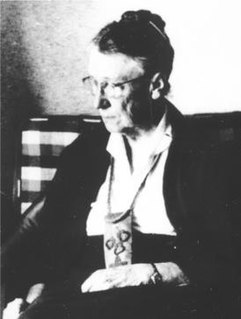
Grace Mead de Laguna was an American philosopher who taught at Bryn Mawr College in Pennsylvania.

Cora Alice Du Bois was an American cultural anthropologist and a key figure in culture and personality studies and in psychological anthropology more generally. She was Samuel Zemurray Jr. and Doris Zemurray Stone-Radcliffe Professor at Radcliffe College from 1954. After retirement from Radcliffe, she was Professor-at-large at Cornell University (1971–1976) and for one term at the University of California, San Diego (1976).
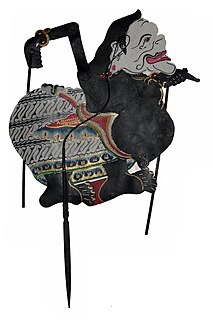
Semar is a character in Javanese mythology who frequently appears in wayang shadow plays. He is one of the punokawan (clowns), but is in fact divine and very wise. He is the dhanyang of Java, and is regarded by some as the most sacred figure of the wayang set. He is said to be the god Sang Hyang Ismaya in human form.
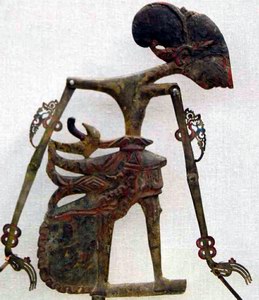
Damarwulan is a Javanese legendary hero who appears in a cycle of stories used in the performance of wayang klitik, as well as Langendriya and ketoprak. These stories tell of the struggles between the Majapahit and Blambangan kingdoms, in which Damarwulan gains honor. The stories are especially popular in East Java.
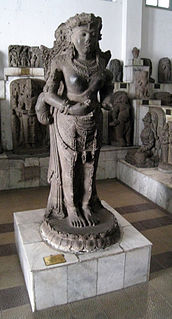
Suhita or Soheeta was a Javanese queen regnant and the sixth monarch of the Majapahit empire, ruling from 1429 to 1447. She was the daughter of Wikramawardhana, her predecessor, by a concubine who was the daughter of Wirabhumi, who was killed in the Regreg civil war with Wikramawardhana. She was succeeded by her brother, Kertawijaya.
Kidung is a form of Old Javanese poetry. They differ from kakawin in that they use Javanese meters instead of imported Sanskrit ones, and mostly appeared later. The subject matter is based on historical events. Like kakawin, they later became an important source of inspiration for pictorial art. They are also distinguished from the tantri, which, though similar in form, are adapted from Indian fables. Many kakawin were also adapted into kidung form.

The Panji tales are a cycle of Javanese stories, centred around the legendary prince of the same name from East Java, Indonesia. Along with the Ramayana and Mahabharata, the tales are the basis of various poems and a genre of wayang known in East Java as wayang gedhog. Panji tales have been the inspiration of Indonesian traditional dances, most notably the topeng (mask) dances of Cirebon and Malang, as well as gambuh dance-drama in Bali. Especially in the environs of Kediri, the suggested homeland of the tales of Panji, local stories grew and were connected with the obscure legendary figure of Totok Kerot. Panji tales have spread from East Java (Indonesia) to be a fertile source for literature and drama throughout Indochina Peninsula and Malay World as well.
George William Skinner was an American anthropologist and scholar of China. Skinner was a proponent of the spatial approach to Chinese history, as explained in his Presidential Address to the Association for Asian Studies in 1984. He often referred to his approach as "regional analysis," and taught the use of maps as a key class of data in ethnography.

George McTurnan Kahin was an American historian and political scientist. He was one of the leading experts on Southeast Asia and a critic of United States involvement in the Vietnam War. After completing his dissertation, which is still considered a classic on Indonesian history, Kahin became a faculty member at Cornell University. At Cornell, he became the director of its Southeast Asia Program and founded the Cornell Modern Indonesia Project. Kahin's incomplete memoir was published posthumously in 2003.
Elfriede Martha Abbe (1919–2012) was an American sculptor, wood engraver and botanical illustrator, often displaying nature and simple country living inspired by her Upstate New York home. A self-publisher, Abbe created numerous hand-printed books, which she printed on a printing press in her studio.
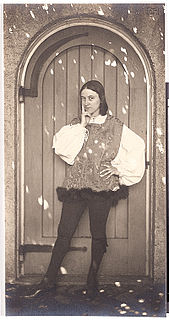
Edith Emerson was an American painter, muralist, illustrator, writer, and curator. She was the life partner of acclaimed muralist Violet Oakley and served as the vice-president, president, and curator of the Woodmere Art Museum in the Chestnut Hill neighborhood of Philadelphia, Pennsylvania, from 1940 to 1978.

Gitel (Gertrude) Poznanski Steed was an American cultural anthropologist known for her research in India 1950–52 involving ethnological work in three villages to study the complex detail of their social structure. She supplemented her research with thousands of ethnological photographs of the individuals and groups studied, the quality of which was recognised by Edward Steichen. She experienced chronic illnesses after her return from the field, but nevertheless completed publications and many lectures but did not survive to finish a book The Human Career in Village India which was to integrate and unify her many-sided studies of human character formation in the cultural/historical context of India.

Daisy Yen Wu was the first Chinese woman engaged as an academic researcher in biochemistry and nutrition. Born into a wealthy industrial family in Shanghai, from a young age she was tutored in English and encouraged to study. She graduated from Nanjing Jinling Women's University in 1921 and then studied in the United States, graduating with a master's degree in biochemistry from Teachers College, Columbia University in 1923. Returning to China, she became an assistant professor at Peking Union Medical College between 1923 and her marriage at the end of 1924 to Hsien Wu. Collaborating with him, she conducted research on proteins and studied nutrition. After their marriage she continued to assist in the research conducted by Wu as an unpaid staff member until 1928. She and her husband collaborated in writing the first Chinese textbook on nutrition, which remained in print through the 1990s.
Ruth Thomas McVey is an American scholar of Indonesia and Southeast Asia known especially for her writings on Communism and the Indonesian Communist Party. With Benedict Anderson, she co-wrote the Cornell Paper, a 1966 work which examined the failed September 30 Movement in Indonesia. She has written and edited a number of books about Indonesian and Southeast Asian politics, including The rise of Indonesian communism (1965) and The Soviet view of the Indonesian revolution (1969).
Hildred Storey Geertz is an American anthropologist who has studied Balinese and Javanese kinship practices and Balinese art in Indonesia.
Grace Cornell Graff, an American ballet and modern dancer, was part of a professional dance duo with her husband, Kurt Graff. During the 1930s, the Graffs established a ballet company, Graff Ballet, and founded the Little Concert House, a dance studio, dance theater, and home, in Chicago, Illinois. In the late 1940s, the Graffs moved to Hopkinton, New Hampshire and turned a colonial home into an artists' colony. The property was known as Meadow Hearth Theatre Art Center.
Karen Harriet Brodine was an American dancer, educator, writer, activist, and typesetter, based in San Francisco and Seattle.